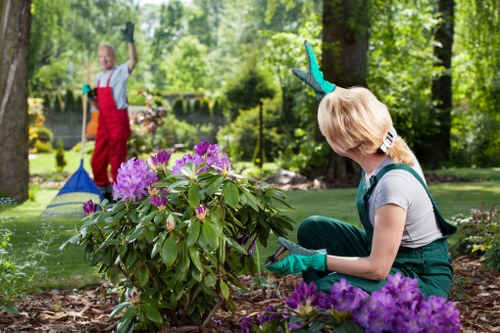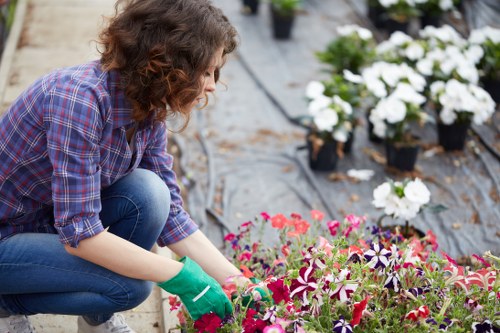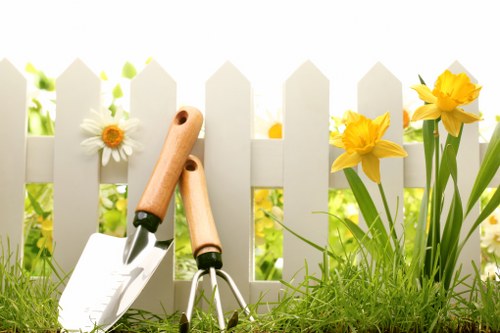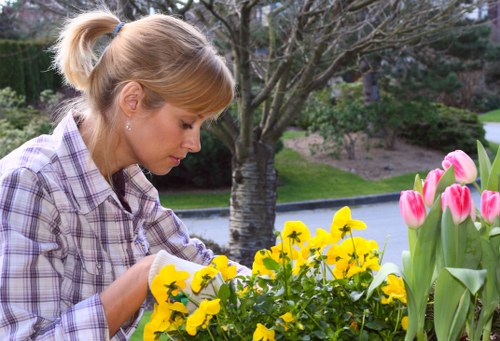Landscape Gardening in Southfields: Transform Your Outdoor Space

Welcome to the vibrant world of landscape gardening in Southfields, where your outdoor space can be transformed into a picturesque haven. Whether you're looking to create a serene garden retreat, a functional outdoor entertaining area, or a lush green space for relaxation, Southfields offers a unique blend of opportunities and challenges for gardening enthusiasts.
Southfields, located in the heart of London, boasts a rich history and diverse community, making it an ideal location for landscape gardening. The area's climate, soil types, and local flora provide a perfect backdrop for creating stunning gardens that not only enhance your property's aesthetic but also contribute to the environment.
In this comprehensive guide, we'll explore the key aspects of landscape gardening in Southfields, including design principles, plant selection, sustainable practices, and maintenance tips to help you achieve a beautiful and thriving garden.

Understanding Landscape Gardening
Landscape gardening is the art of arranging plants, structures, and other elements to create an aesthetically pleasing and functional outdoor space. It combines horticulture, design, and environmental sustainability to enhance the natural beauty of your property.
In Southfields, landscape gardening is particularly rewarding due to the area's moderate climate and varied landscape. Understanding the fundamentals of landscape gardening will help you make informed decisions about design, plant selection, and maintenance.
Here are some essential aspects to consider:
- Design and Layout: Planning the arrangement of various elements in your garden.
- Plant Selection: Choosing plants that thrive in Southfields' climate and soil conditions.
- Sustainability: Implementing eco-friendly practices to reduce environmental impact.
- Maintenance: Regular upkeep to ensure the health and beauty of your garden.

Design Principles for Southfields Gardens
A well-designed garden balances form and function, creating a space that's both beautiful and practical. Here are some key design principles to consider:
1. Balance and Symmetry
Achieving balance in your garden design ensures that no single area overwhelms others. Symmetrical designs often evoke a sense of order and harmony, while asymmetrical arrangements can create visual interest and a more natural look.
Creating Focal Points
Focal points, such as a stunning tree, a water feature, or a piece of garden art, draw the eye and provide a central focus for your garden. Strategically placing focal points can enhance the overall design and guide visitors through the space.
Pathways and Flow
Well-designed pathways guide visitors through different areas of the garden, ensuring smooth flow and accessibility. Consider using materials like gravel, paving stones, or natural stone to create attractive and functional walkways.
2. Texture and Color
Incorporating a variety of textures and colors adds depth and interest to your garden. Mix different plant types, foliage textures, and bloom colors to create a dynamic and visually appealing landscape.
Seasonal Interest
Select plants that provide color and texture throughout the year. Incorporate evergreens, spring bulbs, summer perennials, and autumn foliage to ensure your garden remains vibrant across seasons.
Complementary Colors
Choose color schemes that complement each other, enhancing the overall aesthetic of your garden. Harmonious color combinations create a pleasing and cohesive look.
3. Scale and Proportion
Consider the size and proportion of plants and garden elements in relation to your space. Proper scaling ensures that your garden feels balanced and that no elements appear too large or too small.
Plant Height and Spread
Arrange plants based on their height and spread, placing taller plants towards the back and shorter ones in the front. This arrangement creates a layered effect and allows all plants to be easily viewed.
Space Utilization
Maximize the use of available space by incorporating vertical gardening techniques, such as trellises and vertical plantings, especially in smaller gardens.

Choosing the Right Plants for Southfields
Plant selection is crucial to the success of your landscape garden. Southfields' climate, characterized by mild winters and warm summers, supports a wide range of plant species. Here are some categories to consider:
1. Perennials
Perennials come back year after year, providing long-term color and structure to your garden. Some popular choices for Southfields include:
- Lavender: Known for its fragrant blooms and drought tolerance.
- Hostas: Ideal for shaded areas with their attractive foliage.
- Rudbeckia: Bright yellow flowers that attract pollinators.
2. Shrubs and Bushes
Shrubs add height and density, creating privacy screens and structural elements. Consider the following:
- Boxwood: A versatile evergreen used for hedges and topiary.
- Hydrangeas: Large, showy blooms that thrive in partial shade.
- Roses: Classic flowers available in a variety of colors and fragrances.
3. Trees
Trees provide shade, habitat for wildlife, and a sense of permanence to your landscape. Suitable options include:
Deciduous Trees
These trees shed their leaves annually, offering seasonal interest.
- Oak: A majestic tree with strong branches and rich foliage.
- Cherry Blossom: Known for stunning spring blooms.
Evergreen Trees
Evergreens maintain their foliage year-round, offering consistent greenery.
- Pine: A classic evergreen with needle-like leaves.
- Holly: Features glossy leaves and bright berries.
4. Groundcovers
Groundcovers help prevent soil erosion, suppress weeds, and add texture to your garden floors. Popular choices:
- Hostas: Excellent for shaded areas with their lush foliage.
- Thyme: A fragrant option that thrives in sunny spots.
- Mondo Grass: Provides a neat, carpet-like appearance.
5. Annuals and Bulbs
Annuals and bulbs provide seasonal bursts of color and can be changed annually to refresh your garden's appearance.
- Marigolds: Bright, cheerful flowers that deter pests.
- Tulips: Elegant spring blooms available in various colors.
- Petunias: Versatile flowers that thrive in containers and garden beds.

Sustainable Landscaping Practices
Embracing sustainability in landscape gardening not only benefits the environment but also enhances the longevity and resilience of your garden. Here are key practices to implement:
1. Water Conservation
Efficient water use is essential, especially during dry spells. Implement the following strategies:
- Drip Irrigation: Delivers water directly to plant roots, minimizing evaporation.
- Rainwater Harvesting: Collects and stores rainwater for garden use.
- Drought-Tolerant Plants: Select species that require less water once established.
2. Soil Health
Healthy soil supports robust plant growth and reduces the need for chemical fertilizers.
- Composting: Recycles organic waste into nutrient-rich soil amendments.
- Mulching: Retains moisture, regulates soil temperature, and suppresses weeds.
- Cover Crops: Improve soil structure and fertility during off-seasons.
3. Native Plants
Incorporating native plant species supports local biodiversity and reduces maintenance needs.
- Pollinator-Friendly Plants: Attract bees, butterflies, and other beneficial insects.
- Wildlife Habitat: Create environments that support birds, bats, and other wildlife.
4. Organic Practices
Avoid synthetic chemicals by using organic alternatives for pest control and fertilization.
- Integrated Pest Management (IPM): Combines biological, cultural, and mechanical methods to control pests.
- Natural Fertilizers: Use compost, manure, and other organic materials to nourish plants.
5. Energy Efficiency
Design your garden to take advantage of natural light and wind patterns, reducing the need for artificial heating or cooling.
- Strategic Planting: Position trees and shrubs to provide shade in summer and allow sunlight in winter.
- Windbreaks: Use barriers to protect delicate plants from harsh winds.
Maintaining Your Landscape Garden
A beautiful landscape garden requires regular maintenance to ensure its health and appearance. Follow these tips to keep your Southfields garden thriving:
1. Regular Watering
Consistent watering schedules help plants establish strong roots and remain resilient against pests and diseases.
Deep Watering
Water deeply but infrequently to encourage deep root growth, making plants more drought-resistant.
Morning Irrigation
Watering early in the day reduces evaporation and minimizes the risk of fungal diseases.
2. Pruning and Trimming
Regular pruning promotes healthy growth, removes dead or diseased branches, and maintains the desired shape of plants.
Tools and Techniques
Use sharp, clean tools to make precise cuts, and follow proper pruning techniques for each plant type.
Timing
Prune at the appropriate times of year to support optimal plant health and flowering.
3. Weeding
Remove weeds regularly to prevent competition for nutrients, water, and light.
Mulching
Apply mulch to suppress weed growth and retain soil moisture, reducing the frequency of weeding.
Manual vs. Chemical Control
Opt for manual weeding or organic herbicides to maintain an eco-friendly garden environment.
4. Fertilizing
Provide essential nutrients to support plant growth and vitality.
Soil Testing
Conduct soil tests to determine nutrient deficiencies and select appropriate fertilizers.
Organic Fertilizers
Use compost, manure, or commercial organic fertilizers to enrich the soil naturally.
5. Pest and Disease Management
Monitor plants regularly for signs of pests and diseases to address issues promptly.
Identification and Prevention
Identify common local pests and diseases, and implement preventive measures such as proper spacing and sanitation.
Natural Remedies
Utilize biological controls like beneficial insects and organic sprays to manage infestations.
6. Seasonal Maintenance
Adjust your maintenance routine according to the seasons to prepare your garden for changing weather conditions.
Spring
Clean up debris, plant new seeds or bulbs, and apply fertilizers.
Summer
Focus on watering, weeding, and managing pests to support plant health.
Autumn
Prepare for winter by pruning, mulching, and planting cover crops if desired.
Winter
Protect delicate plants from frost and reduce maintenance activities, allowing the garden to rest.
Benefits of Landscape Gardening in Southfields
Engaging in landscape gardening offers numerous benefits that enhance both your personal well-being and the broader community:
- Aesthetic Appeal: A well-designed garden beautifies your property and increases its value.
- Environmental Impact: Gardens contribute to air purification, habitat creation, and carbon sequestration.
- Health and Well-being: Gardening promotes physical activity, reduces stress, and provides a peaceful outdoor retreat.
- Community Engagement: Shared green spaces foster social interactions and strengthen community bonds.
- Economic Value: Green spaces can attract visitors and potential buyers, boosting local economies.
Environmental Benefits
Landscape gardens play a critical role in environmental sustainability:
- Air Quality Improvement: Plants absorb pollutants and produce oxygen, enhancing the air quality.
- Water Management: Gardens help in managing rainwater runoff, reducing the risk of flooding and erosion.
- Biodiversity Support: Diverse plant species provide habitats for various wildlife, promoting ecological balance.
Personal Benefits
Creating and maintaining a landscape garden can significantly improve your quality of life:
- Stress Reduction: Spending time in a garden has been shown to lower stress levels and improve mental health.
- Physical Exercise: Gardening activities like planting, digging, and pruning provide a moderate form of exercise.
- Sense of Accomplishment: Watching your garden grow and thrive offers a rewarding sense of achievement.
Community Benefits
Beautiful gardens contribute to the overall appeal and cohesion of the community:
- Social Interaction: Gardens serve as common spaces where neighbors can gather and interact.
- Local Wildlife: Gardens provide habitats for birds, bees, and other beneficial creatures, enhancing local biodiversity.
- Economic Advantages: Well-maintained green spaces can increase property values and attract new residents or businesses.
Hiring Professional Landscape Gardeners in Southfields
While DIY landscaping is possible, hiring professional landscape gardeners can ensure a high-quality and expertly crafted garden. Here are the advantages of working with professionals:
1. Expertise and Experience
Professional landscapers bring specialized knowledge and experience in design, plant selection, and maintenance practices tailored to Southfields' specific conditions.
2. Customized Design
They create customized garden plans that reflect your personal style, preferences, and functional needs, ensuring a unique and personalized outdoor space.
3. Time and Efficiency
Professionals manage the entire landscaping process efficiently, saving you time and ensuring timely completion of the project.
4. Quality Materials and Sustainability
Experienced landscapers use high-quality materials and sustainable practices, enhancing the longevity and eco-friendliness of your garden.
5. Ongoing Maintenance
Many professionals offer maintenance services, ensuring your garden remains healthy and beautiful throughout the year.
6. Cost-Effective Solutions
While there is an upfront cost, professional landscaping can be cost-effective in the long run by preventing mistakes and promoting efficient resource use.
Conclusion
Landscape gardening in Southfields offers a rewarding way to enhance your outdoor living space, contribute to environmental sustainability, and improve your overall well-being. By understanding the fundamentals of garden design, selecting the right plants, implementing sustainable practices, and maintaining your garden diligently, you can create a stunning landscape that reflects your personal style and thrives in Southfields' unique environment.
Whether you're a seasoned gardener or just starting, consider reaching out to local landscape professionals to help bring your vision to life. Contact us today to begin your journey towards a beautiful and sustainable garden.
Book your service now and transform your outdoor space into the garden of your dreams!

